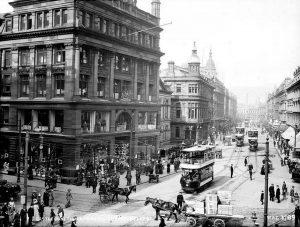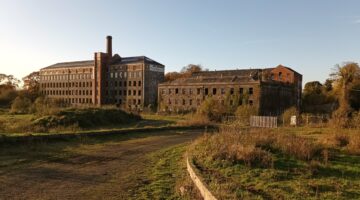 Belfast’s listed ‘Bank Buildings’, more recently familiar as ‘Primark’, were built between 1885-1900, to designs by W H Lynn, and, located at a pivotal point in the Belfast City Centre Conservation Area.
Belfast’s listed ‘Bank Buildings’, more recently familiar as ‘Primark’, were built between 1885-1900, to designs by W H Lynn, and, located at a pivotal point in the Belfast City Centre Conservation Area.
Bank buildings are B1 listed for their architectural and historical significance. The building’s qualities of style, proportion and detail, together with the then innovative use of a steel frame which enabled the incorporation of much larger windows, strongly reflect the success of a city that was one of the most important and prosperous centres for trade and industry in the then British Empire. A fine example of High Victorian style, the Bank Buildings form part of an important cluster of heritage buildings centred on Castle Junction which are seen to be a lynch pin in the surviving architectural heritage and individuality of Belfast City Centre.
Ulster Architectural Heritage appreciates and commends the heritage commitment and significant investment that Primark have put into the Bank Buildings and extend our best wishes to the company and the staff at this very difficult time.
Tuesday’s catastrophic fire is the latest episode in the ongoing story of the cumulative loss of the Heritage Assets which are the soul of the City and without which its unique sense of place cannot survive.
Over the past ten years Belfast has haemorrhaged heritage buildings to the point that the City is approaching crisis point, where the remaining asset is potentially so degraded and scattered that the spirit of the place is in imminent danger of being lost.
Cumulative losses due to land banking by speculators inviting neglect, vandalism and arson; unauthorised demolitions, and, crucially, an appallingly short term approach to development planning by successive responsible authorities, all adds up to unsustainable squandering of an irreplaceable asset.
A lesson can be learned by drawing a parallel with the iconic Mackintosh Art School in Glasgow, devastated by two enormous fires while in the course of refurbishment. While no one would suggest that the Bank Buildings compare to the unique Rennie Mackintosh building it is the relative importance to the City that is relevant, and the clear will to return a seriously damaged Glasgow landmark to the list of the City’s unique selling points.
Given that, as in Glasgow, the Bank buildings will have been insured as a listed building and against fire, Ulster Architectural Heritage would like to see an immediate and clear commitment from Belfast City Council for the retention of the surviving Bank Buildings structure, shored up and made safe and, as with the Mackintosh, only essential and careful demolition undertaken with the removed stonework preserved for reuse in the rebuild.
Also, and again as with the Mackintosh, several important questions must be asked:
How did a heritage building packed daily with retail customers burn to the ground, unusually from the top down: was a sprinkler system installed and operational?
Was the Fire Safety Certificate current and as per current regulations? Are all the main heritage assets in Belfast protected by the sprinklers, fire insurance and current fire certificates required by the City council for the many new buildings currently replacing lost heritage?


